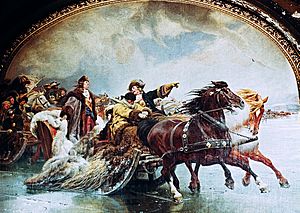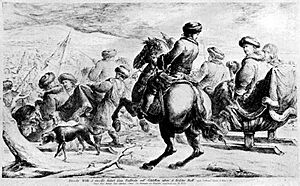Great Sleigh Drive facts for kids
Quick facts for kids Great Sleigh Drive |
|||||||
|---|---|---|---|---|---|---|---|
| Part of Scanian War | |||||||
 Frederick William pursues Swedish troops across the frozen Curonian Lagoon; fresco by Wilhelm Simmler, ca. 1891 |
|||||||
|
|||||||
| Belligerents | |||||||
| Commanders and leaders | |||||||
| Frederick William | Henrik Horn | ||||||
| Strength | |||||||
| 14,000–15,000 34 guns |
6,000–7,000 | ||||||
| Casualties and losses | |||||||
| 1,000–2,000 dead, captured or deserted | |||||||
The Great Sleigh Drive (called Die große Schlittenfahrt in German) was an amazing military move. It happened from December 1678 to February 1679. This daring plan used many sleighs to help Frederick William. He was known as the Great Elector of Brandenburg-Prussia. His goal was to push Swedish soldiers out of the Duchy of Prussia. The Swedes had invaded this area in November 1678.
Why the Sleigh Drive Happened
Frederick William had already beaten the Swedes before. He drove them out of Brandenburg at the Battle of Fehrbellin. Now, the Swedes had invaded his lands again. This time, they wanted to get revenge and steal from the region.
Most of Frederick's army was busy far away. They were attacking Stralsund, a Swedish port city on the Baltic Sea. So, Frederick marched his army to a small town called Preußisch Holland. There, he fought a small group of Swedish soldiers.
The Swedes had lost badly at Fehrbellin. They did not want to fight Frederick William again. They decided to leave and go back to Sweden. They had already taken many valuable things from the area.
The Amazing Sleigh Drive
Most military leaders would have just let the Swedes leave. But Frederick William was very bold and smart. He came up with a brilliant idea. He ordered thousands of sleighs from local farmers. These sleighs would carry his army across the snowy land in the Duchy of Prussia.
This plan was like an early version of using vehicles to move soldiers quickly. His army traveled over deep snow and frozen lakes. Frederick managed to get behind the Swedish forces. This stopped them from reaching the coast. If they reached the coast, they could get supplies or escape by ship.
What Happened Next
Frederick's army rode all the way to Memel. This completely cut off the Swedes from the sea. Frederick wanted to force the Swedes into a big battle. But his forces never actually had to fight them directly.
Many Swedish soldiers died during the harsh winter. They suffered from extreme cold (called hypothermia) and from not having enough food (called starvation). The Swedish army was almost completely destroyed. This victory made Frederick William famous as a great military leader.


